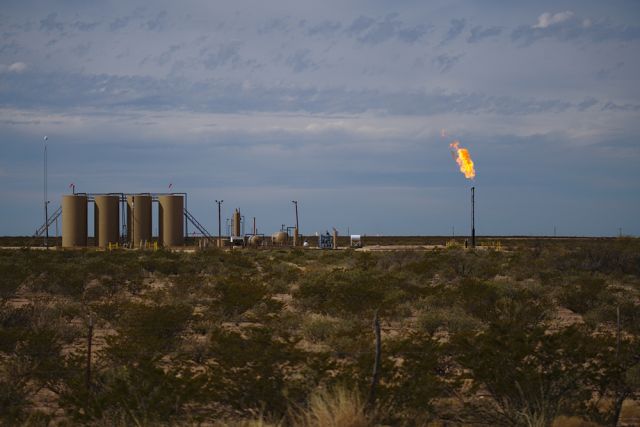
Waha Hub natural gas prices in the Permian traded below zero on March 14. (Source: Shutterstock.com)
The Waha Hub natural gas spot price in the Permian Basin traded below $0.50 per MMBtu on March 14, an executive for Enterprise Products Partners (EPD) said at an industry lunch later in the day.
At 9 a.m., Andrew Fletcher, KeyBank National Association senior vice president for commodity derivatives, wrote in an email that Waha 2024 bids were at negative $0.77 and 2025 bids at negative $0.69.
“Don’t worry about it, we have the gas,” Anthony Chovanec, an Enterprise Products executive vice president, told a lunch crowd at the Greater Houston Port Bureau Commerce Club. “Natural gas, today in Waha, Texas, is trading negative. That means you had to pay me to take your natural gas. You had to pay me somewhere between 50 [cents] and 75 cents to take it.”
The Waha Regional Hub is located outside of Fort Stockton, Texas, in the Permian Basin. Prices at the regional hub were not publicly available at the end of the day. The Henry Hub price for natural gas rose by 5.73% and closed March 14 at $1.75.
The Waha Hub price is challenged thanks to its connection to Permian Basin oil production. According to the EIA, the Waha price fell below zero for the first time this year on March 4 and was trading at -$0.25/MMBtu by March 6.
Negative prices happen when supply exceeds regional demand and the capacity to ship to another market. The EIA noted that the El Paso Natural Gas Co. pipeline system, operated by Kinder Morgan, had been undergoing scheduled maintenance that restricted takeaway capacity.
Chovanec said gas production in the Permian remains high because the region’s producers are focused far more on crude production. Currently, each barrel of Permian crude will be about 25% NGL and 25% natural gas.
The weather conditions in West Texas can also greatly affect the price, thanks to the region’s extremely developed wind turbine facilities.
“It happens when the weather is mild or when the wind is blowing because there’s so much wind generation out in West Texas,” he said. “So, you take the gas load off.”
The National Weather Service monitored strong winds in the Texas Panhandle on March 14, reaching up to 30 miles per hour.
Chovanec pointed out the readiness of the LNG export market to drastically expand in the near term. The market is expected to provide an outlet for natural gas exports and improve prices as Gulf Coast facilities come online.
The export capacity of U.S. LNG is expected to more than double by 2027 to 24.3 Bcf/d, according to the U.S. Energy Information Administration. Some industry critics have said the expansion is an overbuild for the U.S. natural gas supply.
Recommended Reading
Crescent Energy to Buy Eagle Ford’s SilverBow for $2.1 Billion
2024-05-16 - Crescent Energy’s acquisition of SilverBow Resources will create the second largest Eagle Ford Shale E&P with production of about 250,000 boe/d, the companies said.
Diamondback’s Van’t Hof Plays Coy on Potential Delaware Divestiture
2024-05-16 - Diamondback Energy’s President and CFO Kaes Van't Hof also addressed new Permian exploration and the lack of “fun” dealing with the FTC on its deal to buy Endeavor Energy Resources.
Minerals Market Growing But Needs More Scale, Consolidation
2024-05-15 - The market value of public minerals and royalties companies has doubled since 2019—but the sector needs to grow even larger to attract generalist investors into the fray, experts say.
ONEOK CEO: ‘Huge Competitive Advantage’ to Upping Permian NGL Capacity
2024-03-27 - ONEOK is getting deeper into refined products and adding new crude pipelines through an $18.8 billion acquisition of Magellan Midstream. But the Tulsa company aims to capitalize on NGL output growth with expansion projects in the Permian and Rockies.
TotalEnergies, Sinopec to Develop SAF Unit in China
2024-03-26 - TotalEnergies and Sinopec’s production unit will have the capacity to produce 230,000 tons of sustainable aviation fuel per year.





